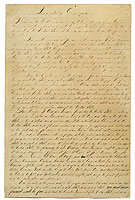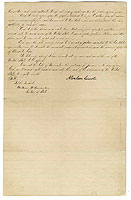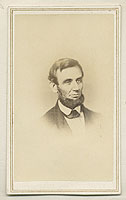![]()
Manuscript Copy of the Emancipation Proclamation, 1863.
![]()
![]()
Photograph of Abraham Lincoln, ca. 1860s.
Abraham Lincoln
![]()
In a nation where the South clung to slavery and the majority of the North
was against abolition, Lincoln was forced to walk a dangerous tightrope.
Personally, Lincoln loathed slavery and the contradiction it posed to
America’s founding ideal of liberty. Finding it difficult to reconcile
these opposing principles and satisfy everyone, he embraced gradual abolition,
African colonization of slaves, and financial compensation for slave owners.
He reasoned that while Southerners might free their slaves, white prejudice
made it impossible for blacks and whites to coexist successfully in the
same society.
However, with constant pressure from abolitionists, beleaguered Union troops, and the South’s absolute refusal to end slavery, Lincoln’s thinking and policy began to evolve. Perhaps he knew that putting an end to slavery was the only way to save the Union. Whatever the reason, he did what all of his predecessors had failed to do: he upheld the integrity of the United States’ founding principles by beginning to legally dismantle slavery.
Shown here is the first engrossed copy of the Emancipation Proclamation made from the manuscript draft that was sent to the State Department.
![]()
- Abraham Lincoln
- Grand Celebration
| |
| |
| |
| |
| |
| |
| |
| |
| |
| |
| |
| |

Copyright © 2002 Division
of Rare & Manuscript Collections
2B Carl A. Kroch Library, Cornell University, Ithaca, NY, 14853
Phone Number: (607) 255-3530. Fax Number: (607) 255-9524
For reference questions, send mail to:
rareref@cornell.edu
For questions or comments about the site, send mail to: webmaster.


